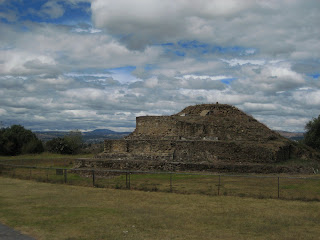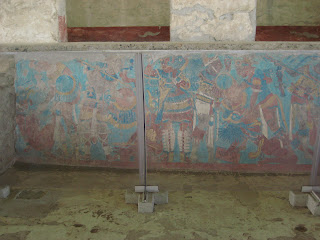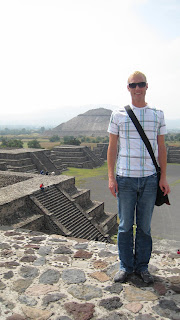




 Found within the municipal government building in the centro of Tlaxcala, these murals tell the story of Tlaxcala's history. They are incredibly done and it was interesting to spend some time here, looking at all of this history painted onto the walls of a government building (as in many other places in Mexico). Of course, the Tlaxcalan history is what makes the people living in Tlaxcala today a very proud people (it is said that they are a proud people; by spending an afternoon there, I didn't really become involved with the local culture and people enough to comment, but these murals are a display of Tlaxcalan pride-remember, they made an historic alliance with Cortes and the Spaniards and it is truly the Tlaxcalans that overthrew the Mexica of Tenochtitlan).
Found within the municipal government building in the centro of Tlaxcala, these murals tell the story of Tlaxcala's history. They are incredibly done and it was interesting to spend some time here, looking at all of this history painted onto the walls of a government building (as in many other places in Mexico). Of course, the Tlaxcalan history is what makes the people living in Tlaxcala today a very proud people (it is said that they are a proud people; by spending an afternoon there, I didn't really become involved with the local culture and people enough to comment, but these murals are a display of Tlaxcalan pride-remember, they made an historic alliance with Cortes and the Spaniards and it is truly the Tlaxcalans that overthrew the Mexica of Tenochtitlan).


 Here are a few more images of the city of Tlaxcala. Frida Kahlo and I, and a few more Catholic churchs. I would love to know how many Catholic churches are in all of Mexico; I'm sure the number is staggering.
Here are a few more images of the city of Tlaxcala. Frida Kahlo and I, and a few more Catholic churchs. I would love to know how many Catholic churches are in all of Mexico; I'm sure the number is staggering.

 This is what Cacaxtla looks like. It's in the southwestern corner of the state of Tlaxcala. Cacaxtla was built and occupied during 600-800CE by the Olmeca-Xicalanca people and we don't really know who they were. Archaeological sites that are being reconstructed can look like Cacaxtla does at the present moment; there were many workers there, trying to help preserve these structures. We weren't able to go to the pyramid up on the hill, but it looks very interesting.
This is what Cacaxtla looks like. It's in the southwestern corner of the state of Tlaxcala. Cacaxtla was built and occupied during 600-800CE by the Olmeca-Xicalanca people and we don't really know who they were. Archaeological sites that are being reconstructed can look like Cacaxtla does at the present moment; there were many workers there, trying to help preserve these structures. We weren't able to go to the pyramid up on the hill, but it looks very interesting.


 Here are some amazing murals of warriors and sacrifice. The colors, after more than a millenia, are still so vibrant. The interesting thing is that many of these images are very similar to Maya images and iconography. The origin of the Olmeca-Xicalanca peoples is not completely understood so it is possible that these people were somehow related to the Maya or had interacted with the Maya somehow, someway. I'm learning that with all of the knowledge that we do have about the different Mesoamerican cultures, we really have so much contradictory evidence and so many more gaps and questions. And that's why we need to continue excavating and exploring, broadening our understanding of these ancient peoples and cultures.
Here are some amazing murals of warriors and sacrifice. The colors, after more than a millenia, are still so vibrant. The interesting thing is that many of these images are very similar to Maya images and iconography. The origin of the Olmeca-Xicalanca peoples is not completely understood so it is possible that these people were somehow related to the Maya or had interacted with the Maya somehow, someway. I'm learning that with all of the knowledge that we do have about the different Mesoamerican cultures, we really have so much contradictory evidence and so many more gaps and questions. And that's why we need to continue excavating and exploring, broadening our understanding of these ancient peoples and cultures.






































